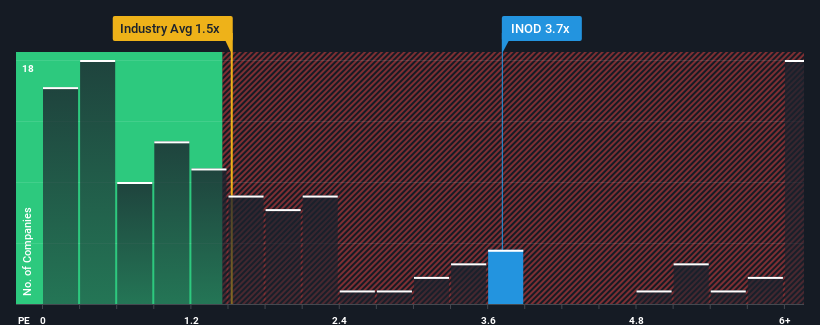- United States
- /
- Professional Services
- /
- NasdaqGM:INOD
Why We're Not Concerned Yet About Innodata Inc.'s (NASDAQ:INOD) 25% Share Price Plunge

Innodata Inc. (NASDAQ:INOD) shares have retraced a considerable 25% in the last month, reversing a fair amount of their solid recent performance. Still, a bad month hasn't completely ruined the past year with the stock gaining 77%, which is great even in a bull market.
Even after such a large drop in price, given around half the companies in the United States' Professional Services industry have price-to-sales ratios (or "P/S") below 1.5x, you may still consider Innodata as a stock to avoid entirely with its 3.7x P/S ratio. However, the P/S might be quite high for a reason and it requires further investigation to determine if it's justified.
Check out our latest analysis for Innodata

What Does Innodata's Recent Performance Look Like?
Recent times have been advantageous for Innodata as its revenues have been rising faster than most other companies. The P/S is probably high because investors think this strong revenue performance will continue. If not, then existing shareholders might be a little nervous about the viability of the share price.
Keen to find out how analysts think Innodata's future stacks up against the industry? In that case, our free report is a great place to start.How Is Innodata's Revenue Growth Trending?
Innodata's P/S ratio would be typical for a company that's expected to deliver very strong growth, and importantly, perform much better than the industry.
If we review the last year of revenue growth, the company posted a terrific increase of 41%. The latest three year period has also seen an excellent 71% overall rise in revenue, aided by its short-term performance. So we can start by confirming that the company has done a great job of growing revenue over that time.
Turning to the outlook, the next year should generate growth of 47% as estimated by the three analysts watching the company. That's shaping up to be materially higher than the 6.2% growth forecast for the broader industry.
With this in mind, it's not hard to understand why Innodata's P/S is high relative to its industry peers. Apparently shareholders aren't keen to offload something that is potentially eyeing a more prosperous future.
What We Can Learn From Innodata's P/S?
Innodata's shares may have suffered, but its P/S remains high. It's argued the price-to-sales ratio is an inferior measure of value within certain industries, but it can be a powerful business sentiment indicator.
Our look into Innodata shows that its P/S ratio remains high on the merit of its strong future revenues. Right now shareholders are comfortable with the P/S as they are quite confident future revenues aren't under threat. It's hard to see the share price falling strongly in the near future under these circumstances.
Before you take the next step, you should know about the 2 warning signs for Innodata that we have uncovered.
If these risks are making you reconsider your opinion on Innodata, explore our interactive list of high quality stocks to get an idea of what else is out there.
New: AI Stock Screener & Alerts
Our new AI Stock Screener scans the market every day to uncover opportunities.
• Dividend Powerhouses (3%+ Yield)
• Undervalued Small Caps with Insider Buying
• High growth Tech and AI Companies
Or build your own from over 50 metrics.
Have feedback on this article? Concerned about the content? Get in touch with us directly. Alternatively, email editorial-team (at) simplywallst.com.
This article by Simply Wall St is general in nature. We provide commentary based on historical data and analyst forecasts only using an unbiased methodology and our articles are not intended to be financial advice. It does not constitute a recommendation to buy or sell any stock, and does not take account of your objectives, or your financial situation. We aim to bring you long-term focused analysis driven by fundamental data. Note that our analysis may not factor in the latest price-sensitive company announcements or qualitative material. Simply Wall St has no position in any stocks mentioned.
About NasdaqGM:INOD
Innodata
Operates as a data engineering company in the United States, the United Kingdom, the Netherlands, Canada, and internationally.
Flawless balance sheet with solid track record.
Similar Companies
Market Insights
Community Narratives



